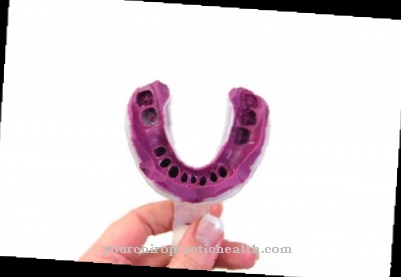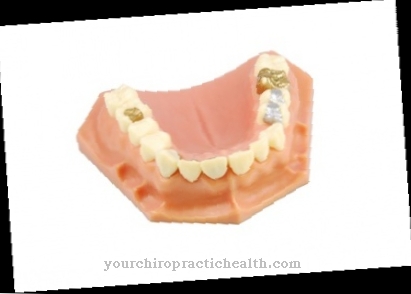Inhalers or Inhalers transport the active ingredients of various drugs into the airways by means of atomization or vaporization. Today inhalers are mostly compressed air or ultrasonic inhalers. The invention of the inhaler has therapeutic benefits for respiratory diseases such as asthma.
What is an inhaler?

With the help of an inhaler, powdered active ingredients are transported into the lower and upper respiratory tract. The finer the atomization of the powder, the deeper the active ingredients penetrate. Extremely finely atomized powder also reaches the bronchi with the help of an inhaler.
The forerunner of all inhalers was the idea of inhaling essential oils, which were dissolved in hot water and inhaled as water vapor. Even today, this type of treatment can still be used, for example, for colds. At the beginning of the 19th century there were the first porcelain inhalers. In the course of the same century, the anesthetic was given through an ether inhaler for anesthesia before operations. Shortly afterwards, plastic, glass and metal for the inhaler were also discovered. Today inhalers primarily serve a purpose in the therapy of various respiratory diseases.
Two systems have prevailed for the devices: the ultrasound system and the compressed air system. Depending on the type of respiratory disease, therapeutic inhalation can in many cases be used on an outpatient basis thanks to modern inhalation devices. This handling was unthinkable for a long time and it was not until the 20th century that it became established with medical and technical progress.
Shapes, types & types
Electric jet nebulisers with steam are the most popular inhalers. In these electrical devices, a compressor generates compressed air. Compressed air is delivered from a nozzle, which presses the active ingredient into a nebulous form. The inhaler breathes in the active ingredient in mist droplets of around three micrometers through a mask or the mouthpiece of the device. The steam thus reaches the deep respiratory tract and penetrates into the smallest ramifications. This type of inhaler must never be used with substances such as essential oils. These substances could clog the nozzle of the device and make the inhaler unusable.
Ultrasonic inhalers work completely differently from jet nebulizers. In these systems, water is made to vibrate. The oscillating movements release the smallest particles from the inhalant, which the inhaler picks up through the mask or mouthpiece. Ultrasonic inhalers are usually operated by a rechargeable battery. Compared to compressed air inhalers, they are quieter and are also capable of even finer nebulization of the active ingredients.
For some time now there have also been vibrating membrane inhalers that also work with vibrations.
Structure & functionality
Jet nebulizers with compressed air work via a compressed air stream that atomizes a drug solution. A similar effect can be observed when blowing through a straw into a water glass. The rising drops pull liquid upwards with them. This is exactly the principle of the nozzle compressed air nebuliser, whereby the system described takes place in these devices on a microscopic level.
Ultrasonic inhalers, on the other hand, contain a tiny transducer for delivering ultrasonic units. In contrast to steam inhalers, the water is not evaporated, but rather atomized in the truest sense of the word. These nebulizers are more effective than other inhalers because they can also transport salts and smaller active ingredients that steam inhalers leave behind in the device. Electrical vibrations are converted into mechanical vibrations in ultrasonic inhalers, which are transferred to the water and thus can form tiny droplets from the liquid.
A more recent invention are inhalers with vibrating membrane technology. A porous and vibrating membrane allows minute particles of the liquid medicament to pass through with each vibration, which are entrained through the mouthpiece. The short duration of treatment for this type of inhalation makes vibrating membrane inhalers particularly popular with children.
For asthmatics, the inhaler is now also available as a pump system for the pocket. The mechanical pumping movement is used to nebulize the emergency medication.
Medical & health benefits
Inhalers are used to treat acute and chronic respiratory diseases. Especially in connection with COPD, asthma and bronchitis, but also with diseases such as cystic fibrosis, they perform important therapeutic functions.
For asthmatics today there are pocket inhalers mentioned above, which are also known as asthma sprays and which initiate the nebulization via a pump mechanism. This invention can even save lives in the event of an acute asthma attack, because it provides immediately applicable self-help. The health benefits of inhalers are correspondingly high.
The doctor decides on a case-by-case basis which type of inhaler is best suited for treating an illness. Steam nebulizers, for example, are often recommended to patients with sinus infections. Ultrasonic inhalers in turn reach the depths of the bronchial tubes and can therefore also help patients with acute bronchitis.
Since many inhaler systems can now be used on an outpatient basis, patients with a respiratory disease are given a certain amount of control and security over their own therapy when they are prescribed the devices. The outpatient and independent use and the certainty that the inhaler is in your own pocket can have a calming effect on the patient. In this way, he can actively contribute to his therapy so that he feels less exposed and can take action himself in emergency situations. In addition to the purely physical level, the inhaler now has an important function on the psychological level.








.jpg)



















